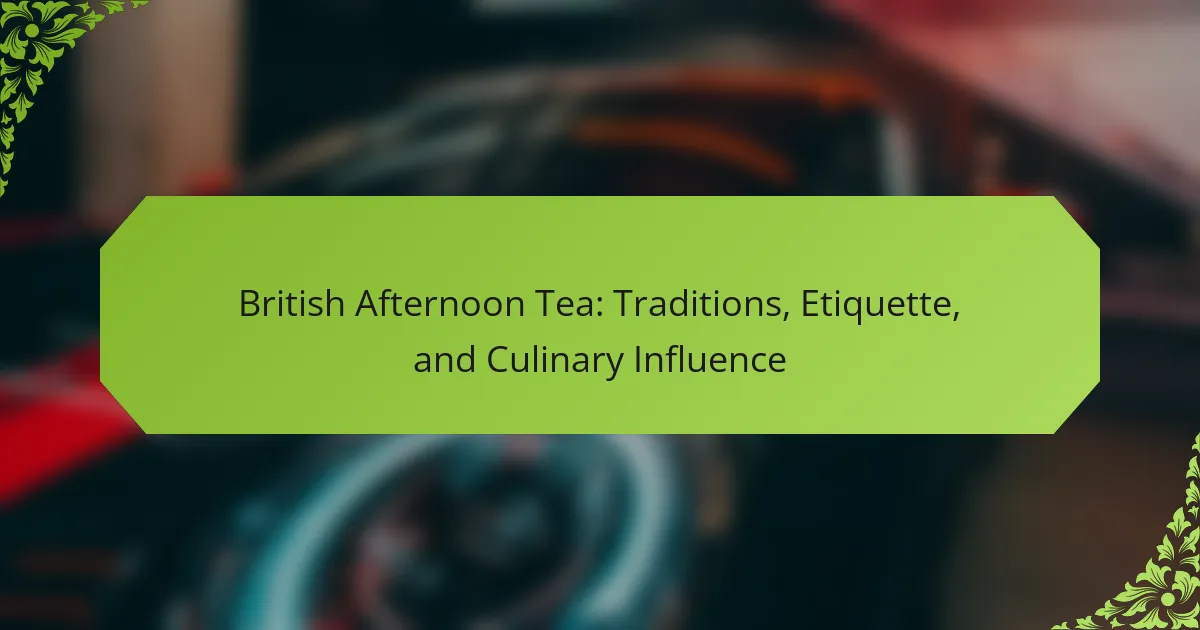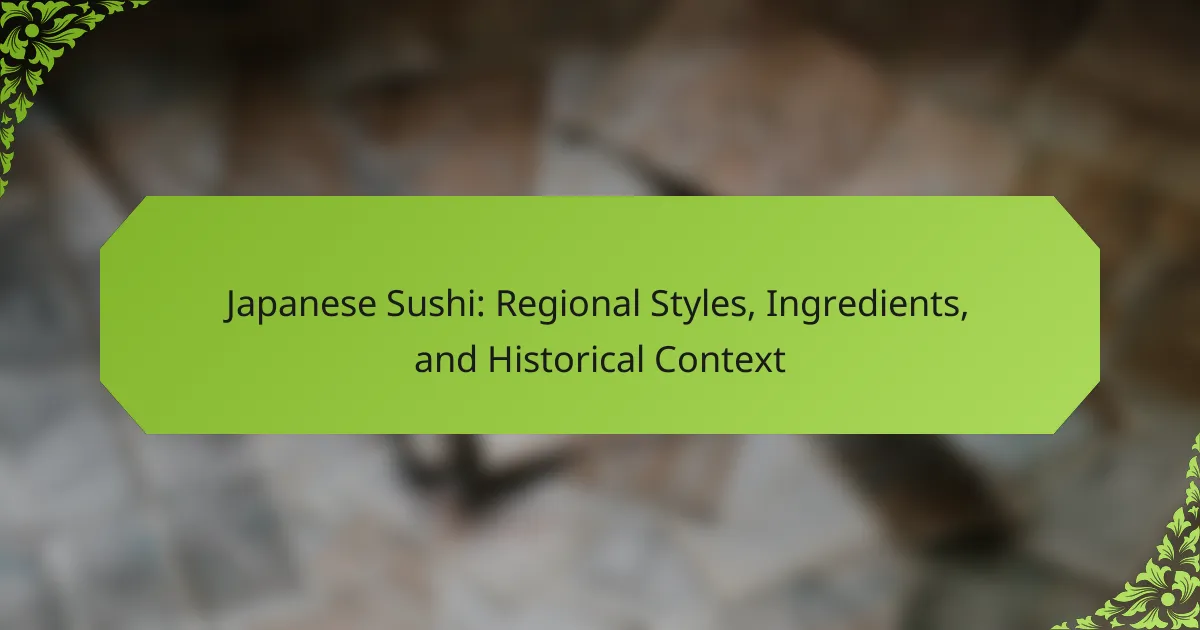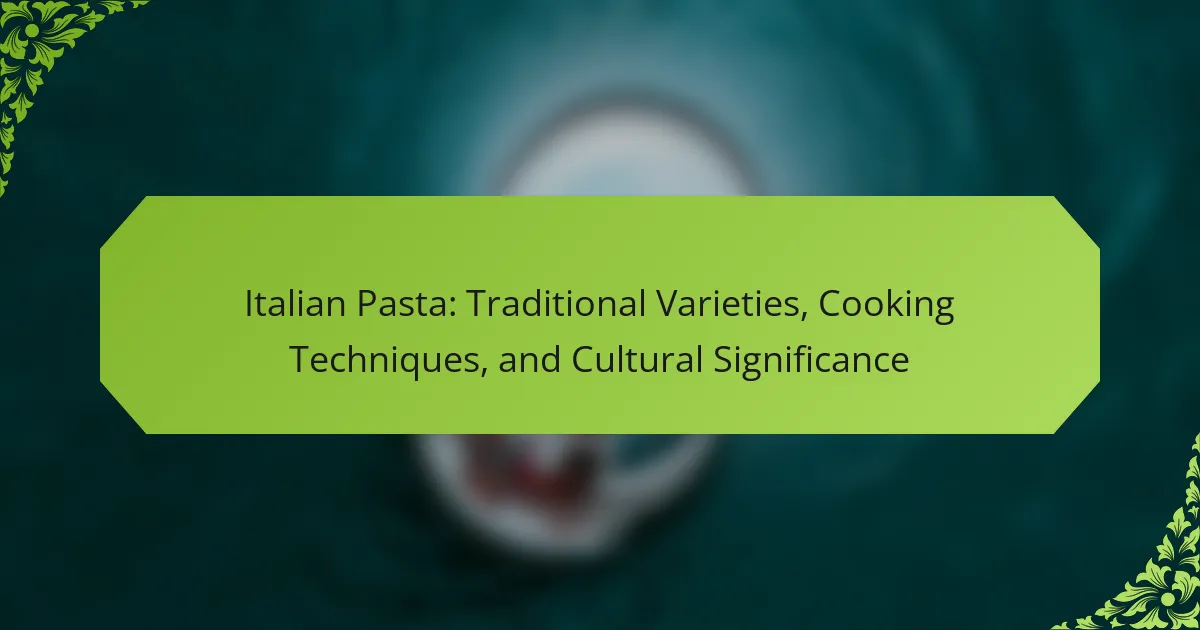British Afternoon Tea offers a unique experience blending tradition and culinary delight. This article explores the key elements of Afternoon Tea, essential etiquette practices, regional variations, and its global culinary influence. Discover how this cherished ritual promotes social interaction and showcases a rich cultural heritage. Learn how to navigate common pitfalls to fully appreciate this iconic British tradition.
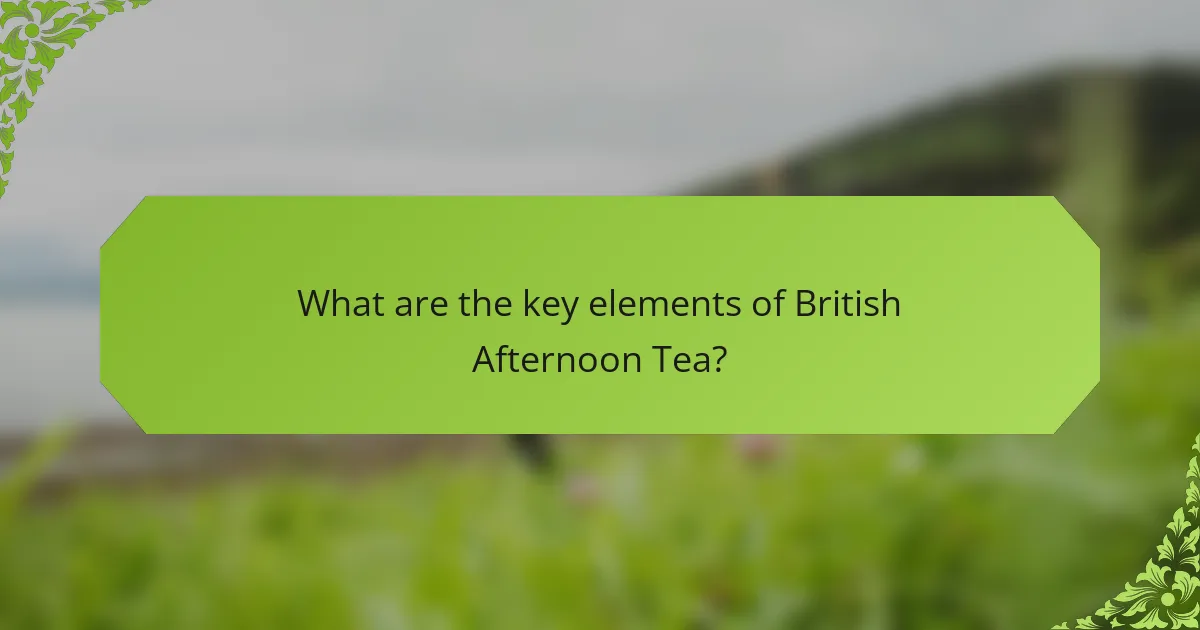
What are the key elements of British Afternoon Tea?
The key elements of British Afternoon Tea include a selection of teas, a variety of sandwiches, scones with clotted cream and jam, and an assortment of pastries. Traditionally served between 3 PM and 5 PM, this ritual emphasizes social interaction and etiquette. Key components include:
– Teas: Typically black teas like Earl Grey or Darjeeling.
– Sandwiches: Cucumber, smoked salmon, and egg mayonnaise are common choices.
– Scones: Served warm, they are a staple, accompanied by clotted cream and jam.
– Pastries: Cakes and tarts add a sweet touch, often featuring seasonal fruits.
This culinary tradition highlights the significance of presentation and serves as a cultural touchstone in British society.
How does the time of day influence the experience?
The time of day significantly influences the experience of British Afternoon Tea. Traditionally served between 3 p.m. and 5 p.m., this timing allows for a relaxing break in the afternoon.
Afternoon tea offers a unique social atmosphere, promoting conversation and connection. The lightness of the menu, featuring delicate sandwiches and pastries, aligns with the day’s progression towards evening. As a result, the ambiance shifts from a formal setting to a more casual, intimate gathering.
Culinary choices also reflect the time of day. Lighter fare is preferred, enhancing the overall experience. The ritual of tea drinking, combined with the day’s natural light, creates a serene environment, making it a cherished tradition in British culture.
Which types of tea are traditionally served?
British afternoon tea traditionally features a variety of tea types, including black, green, and herbal teas. Popular choices are Assam, Darjeeling, and Earl Grey. Each tea complements the accompanying pastries and sandwiches served during this ceremonial meal.
What role do sandwiches and pastries play in the menu?
Sandwiches and pastries are essential components of British afternoon tea, offering variety and balance. Sandwiches provide savory options, typically featuring cucumber, smoked salmon, or egg, while pastries, such as scones and cakes, add sweetness. This combination reflects the tradition of complementing flavors and textures, enhancing the overall experience. The inclusion of these items highlights the social aspect of afternoon tea, promoting conversation and enjoyment among guests.
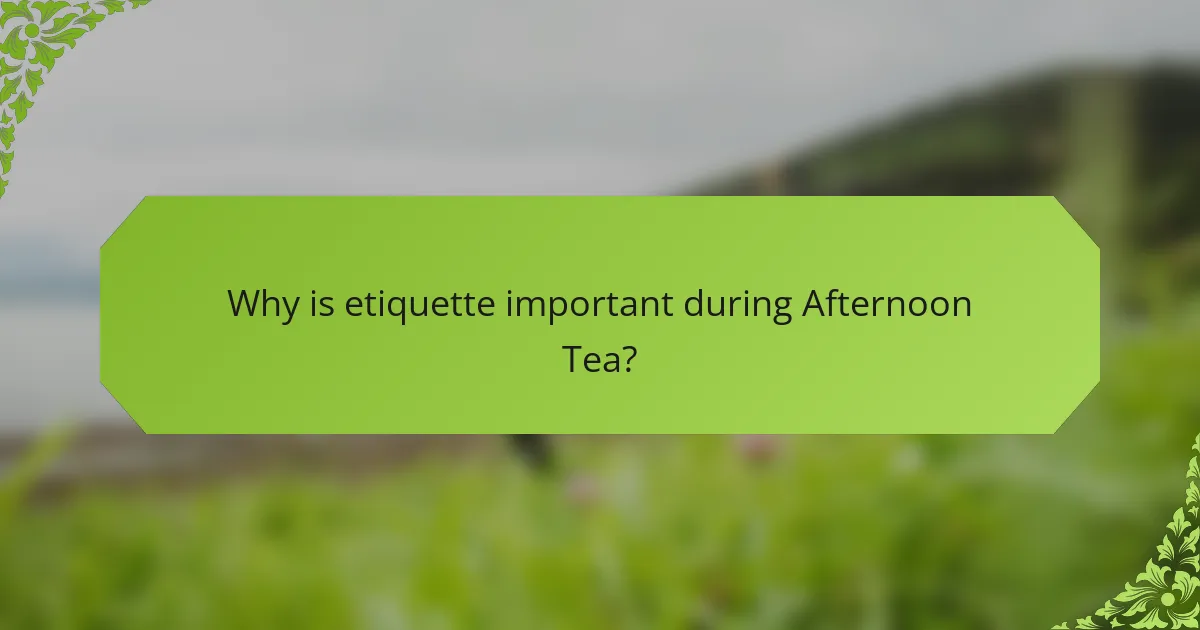
Why is etiquette important during Afternoon Tea?
Etiquette is crucial during Afternoon Tea as it reflects respect, tradition, and social grace. Observing proper manners enhances the experience, fostering a sense of elegance and connection among guests. Key practices include proper seating, polite conversation, and appropriate use of utensils, which all contribute to a refined atmosphere. Following these customs honors the historical significance of Afternoon Tea, ensuring that it remains a cherished social ritual.
What are the dos and don’ts of tea service?
The dos and don’ts of tea service ensure a refined British Afternoon Tea experience.
Dos include serving tea in proper teapots, offering a variety of teas, and providing milk and lemon as options. Use fine china and serve finger sandwiches, scones, and pastries elegantly. Always refill cups and engage guests in conversation.
Don’ts involve oversteeping tea, serving tea at incorrect temperatures, or using teabags in formal settings. Avoid loud discussions and ensure the table remains tidy throughout the service. Never rush guests; allow them to savor the experience.
How should one properly conduct oneself at the table?
To conduct oneself properly at the table during British afternoon tea, observe these etiquette guidelines. Maintain a polite demeanor, engage in light conversation, and avoid discussing controversial topics. Use utensils correctly; for instance, hold the teacup by the handle and do not slurp your tea. Place your napkin on your lap and keep elbows off the table. When finished, place your utensils neatly on the plate to signal you are done.
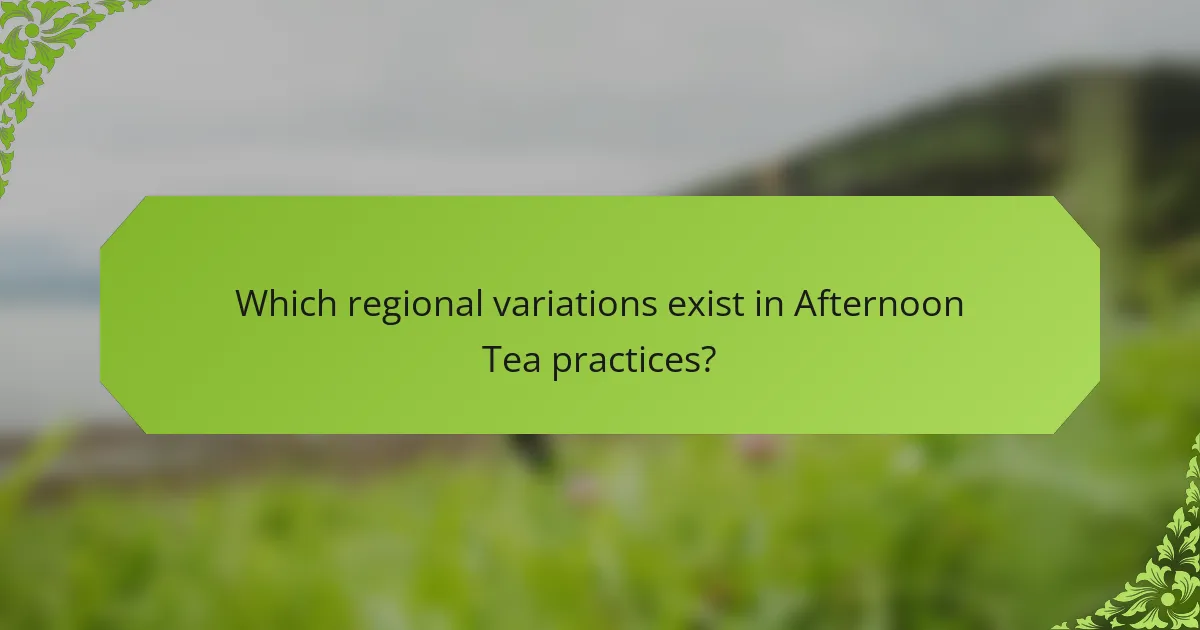
Which regional variations exist in Afternoon Tea practices?
Regional variations in Afternoon Tea practices include distinct customs and menu items across different areas. In England, traditional Afternoon Tea features sandwiches, scones, and pastries. Scotland emphasizes shortbread and oatcakes, while in Ireland, soda bread is common. The United States often adapts this tradition, incorporating a broader range of desserts and lighter fare. Each region showcases unique culinary influences that reflect local tastes and ingredients.
How does Afternoon Tea differ across the UK?
Afternoon Tea varies across the UK in terms of tradition, presentation, and regional specialties. In England, it typically includes a selection of finger sandwiches, scones, and pastries. In Scotland, it may feature more hearty options like oatcakes and shortbread. Wales often incorporates traditional cakes such as bara brith, while Northern Ireland is known for its soda bread and tea cakes. Each region reflects local culinary influences, showcasing unique flavors and customs.
What unique customs are observed in Scotland?
Scotland observes unique customs that reflect its rich cultural heritage. Traditional ceilidh dancing is a social event featuring folk music and dance, fostering community bonding. The practice of haggis consumption during Burns Night honors poet Robert Burns, celebrating Scottish literature. Additionally, the custom of wearing tartan patterns signifies clan identity, showcasing Scotland’s historical significance. The ritual of the Highland Games highlights athletic prowess, featuring events like caber tossing and tug of war, rooted in Scottish tradition.

How has British Afternoon Tea influenced global culinary trends?
British Afternoon Tea has significantly influenced global culinary trends by promoting the concept of tea time and elevating snack pairings. Its emphasis on social interaction and refined presentation has inspired various cultures to adopt similar practices. For instance, countries like Japan and India have integrated their traditional teas with afternoon snacks, creating unique fusion experiences. The ritual of afternoon tea has also led to the popularization of themed tea gatherings and brunches worldwide, showcasing a blend of local and British culinary elements. This adaptation highlights the unique attribute of British Afternoon Tea as a cultural phenomenon that transcends borders, fostering community and shared experiences around food.
What are the modern adaptations of Afternoon Tea?
Modern adaptations of Afternoon Tea include themed events, casual settings, and global influences. These variations maintain the core elements while introducing innovative flavors and presentations. For instance, some venues offer fusion teas that combine traditional British elements with Asian or Mediterranean cuisines. Additionally, social media has inspired visually appealing tea setups, enhancing the experience. Unique attributes such as vegan or gluten-free options cater to diverse dietary preferences, making Afternoon Tea more inclusive.
Which international locations have embraced Afternoon Tea?
Several international locations have embraced Afternoon Tea, including the United States, Japan, and Australia. In these countries, variations of the traditional British Afternoon Tea are popular, often featuring local flavors and customs. For example, New York City offers lavish tea services in luxury hotels, while Tokyo incorporates matcha and seasonal ingredients. Australia has developed its own unique spin with a focus on fresh, local produce. This global adaptation highlights the culinary influence and cultural significance of Afternoon Tea beyond its British origins.
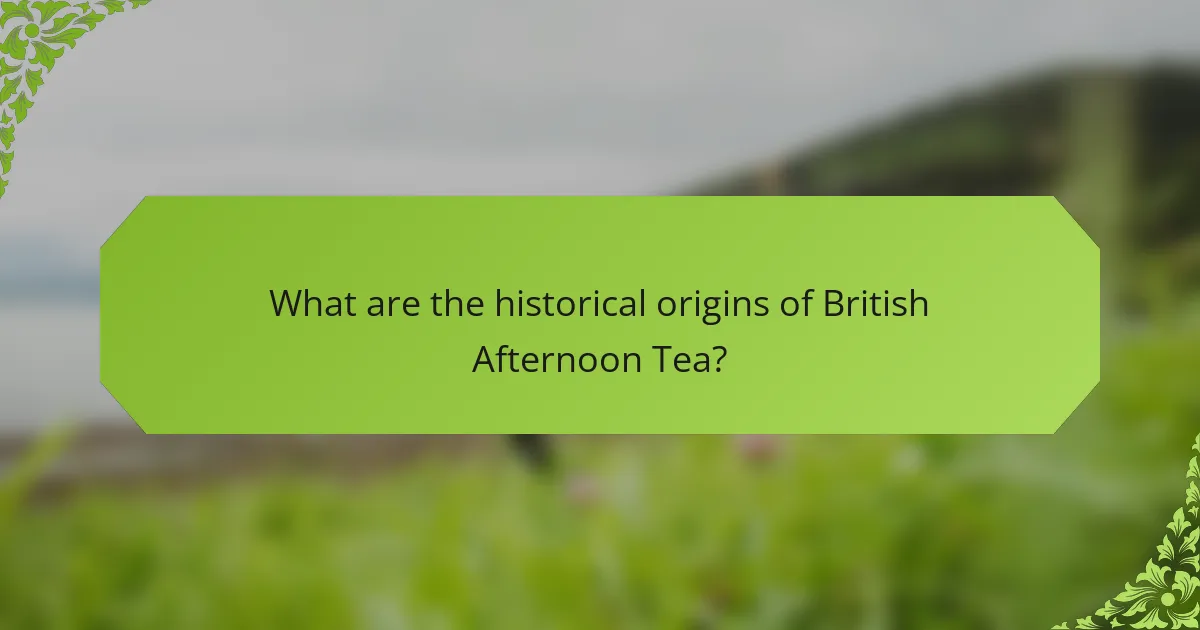
What are the historical origins of British Afternoon Tea?
British Afternoon Tea originated in the early 19th century, attributed to Anna Russell, the Duchess of Bedford. She introduced the practice to combat mid-afternoon hunger. This tradition evolved into a social event, characterized by light refreshments and tea.
The concept gained popularity among the upper classes and became a staple in British culture. Afternoon Tea typically includes a selection of sandwiches, scones, and pastries. The etiquette surrounding it emphasizes proper table settings and polite conversation, reflecting the social norms of the time.
Over the years, Afternoon Tea has influenced culinary practices, leading to variations across different cultures. Today, it remains a cherished British tradition, enjoyed in homes and tea rooms alike.
How did the tradition evolve over time?
British afternoon tea evolved from a social necessity to a refined ritual. Initially popularized by Anna, the Duchess of Bedford, in the early 19th century, it served as a solution to the long gap between lunch and dinner. Over time, it incorporated formal etiquette and an array of culinary delights, such as finger sandwiches, scones, and pastries.
The Victorian era solidified its status as a social event, with elaborate tea sets and venues catering to the affluent. Today, afternoon tea reflects both tradition and innovation, with modern interpretations that include diverse cuisines and themes. This evolution highlights the unique attribute of afternoon tea, merging historical significance with contemporary culinary trends.
What notable figures contributed to its popularity?
Queen Victoria significantly popularized British Afternoon Tea in the 19th century. Other notable figures include Anna Maria Russell, the Duchess of Bedford, who is credited with initiating the practice. Charles Dickens and other literary figures helped to further embed the tradition in British culture. The social elite embraced Afternoon Tea, making it a fashionable event, which influenced its culinary aspects and etiquette.
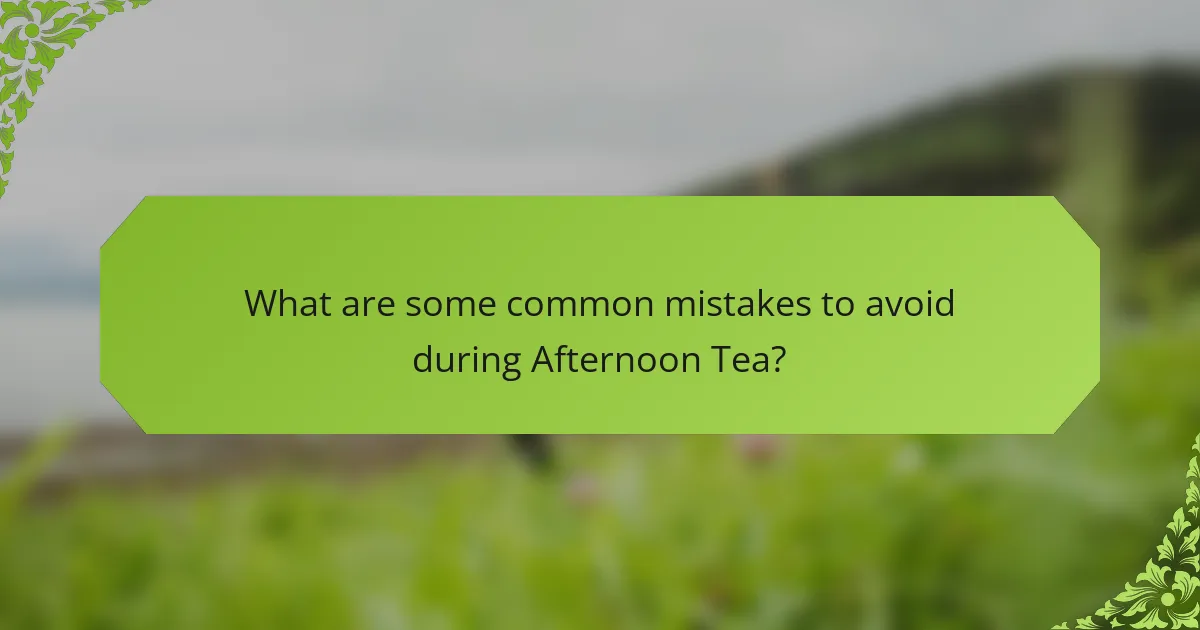
What are some common mistakes to avoid during Afternoon Tea?
To enjoy British Afternoon Tea properly, avoid common mistakes such as neglecting the dress code, serving tea at incorrect temperatures, and not understanding the order of service. These errors can disrupt the experience and etiquette associated with this tradition.
1. Ignoring the dress code: Afternoon Tea often has a formal dress code; casual attire may be inappropriate.
2. Serving tea incorrectly: Black tea should be brewed at 95-100°C; serving it too cold affects flavor.
3. Not following the order of service: Start with sandwiches, then scones, and finish with pastries for an authentic experience.
4. Skipping the proper use of utensils: Use the right utensils for each course to maintain etiquette.
5. Overlooking conversation etiquette: Keep discussions light and pleasant, avoiding controversial topics.
How can one enhance the overall experience?
To enhance the overall experience of British Afternoon Tea, focus on ambiance, presentation, and interaction. Create a serene setting with soft lighting and classical music. Use fine china and elegant table settings to elevate the visual appeal. Encourage conversation by offering a variety of teas and treats, allowing guests to explore flavors. Incorporate traditional elements, such as serving scones with clotted cream and jam, to honor the culinary influence. Lastly, engage guests with stories about the history and etiquette of afternoon tea, enriching their understanding and enjoyment.
What are expert tips for hosting a successful Afternoon Tea?
To host a successful Afternoon Tea, focus on ambiance, menu selection, and etiquette. Create a cozy environment with elegant table settings and soft music. Offer a variety of teas, sandwiches, scones, and pastries, ensuring quality ingredients. Familiarize guests with etiquette, such as how to hold the teacup and the order of service. Consider seasonal themes for a unique touch, enhancing the overall experience.
